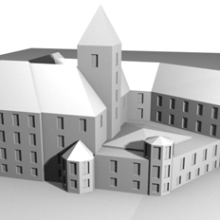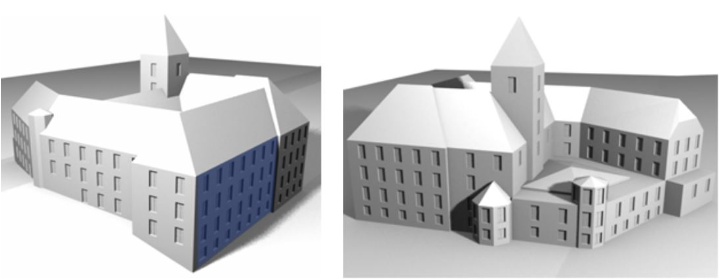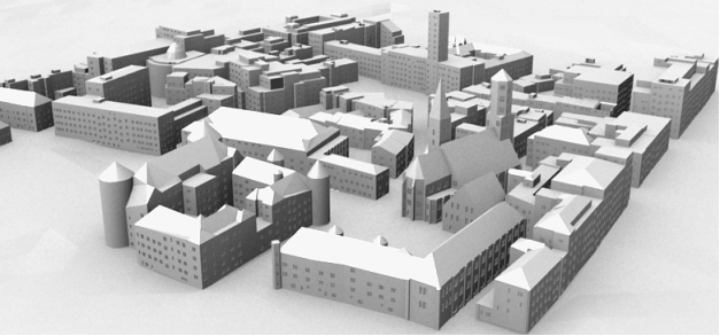Frequently, algorithms for 3D facade reconstruction extract high resolution building geometry like windows, doors and protrusions from terrestrial LiDAR and image data. However, such a bottom-up modelling of facade structures is only feasible if the observed data meets considerable requirements on data quality. Errors in measurement, varying point densities, reduced accuracies, as well as incomplete coverage affect the achievable correctness and reliability of the reconstruction result. For this reason, we enhance the explicit reconstruction of facades by the integration of rules. The rules are derived automatically from already reconstructed facades, which serve as knowledge base for further processing. They are used for the verification of the facade model produced during the data driven reconstruction process and the generation of synthetic facades for which only partially or no sensor data is available.
In principle, object reconstruction is feasible either knowledge based in a top-down fashion or in a bottom-up manner, which is more data driven. Knowledge based techniques usually apply formal grammars that ensure the plausibility and the topological correctness of the reconstructed object elements. A famous example for formal grammars is given by Lindenmayer-systems (L-systems), which can be used to model the growth processes of plants. Since L-systems allow for the procedural modelling of complex objects, they serve as a basis for the development of further grammars appropriate for the modelling of architecture, for instance shape grammars or split grammars. Generally, model based reconstruction techniques provide a means for procedurally creating architecture in a predefined style. However, this style first has to be constituted and translated into some kind of model or grammar description, manually. Another problem is that the variety of facade structures to be generated is restricted to the knowledge base inherent in the grammar rules or model libraries. The appearance of facade elements is limited to prespecified types, even when leaving some freedom in the values of their parameters. In this respect, data driven approaches are more flexible. The facade structure is not subject to predefined rules since geometrical features are directly extracted and modelled from the measured data. As a consequence, such approaches are relatively sensitive to erroneous or incomplete data.
To overcome these difficulties, we pursue an approach for the geometric refinement of planar building facades which runs fully automatically and includes both bottom-up and top-down propagation of knowledge. The goal is to extract rules from observed facade geometries, which are - due to limitations during data acquisition - mostly available only for parts of a building. These rules then can be applied to generate facade structure for the remaining parts of the building. Our algorithm starts with the extraction and modelling of facade geometries using terrestrial LiDAR and image data in a bottom-up fashion as it was suggested in our previous work. After this interpretation step, the resulting reconstructed facade serves as knowledge base for further processing. Dominant or repetitive features and regularities as well as their hierarchical relationship are detected from the modelled facade elements. At the same time, production rules are automatically inferred. The rules together with the 3D representations of the modelled facade elements constitute a formal grammar which we call facade grammar. It contains all the information that is necessary to reconstruct facades in the architectural style of the respective building.
This knowledge is applied in three ways. First, the facade model generated during the data driven reconstruction process can be verified and made more robust against inaccuracies and false reconstructions due to imperfect data. Second, facades which are only partially covered by dense sensor data are completed. Third, totally unobserved facades are synthesized.
As an example, Figure 1 shows the 3D facade model of Stuttgart's Linden-Museum from two different views. The building part that has been modelled during the bottom-up reconstruction is shaded in blue. All remaining facade areas are synthesized based on the grammars inferred from the marked region.
While in that example the grammar concept is applied for the completion of facade structure, grammars can also be used as a "library" to generate building facades for objects, where no measurements are available at all. This step is demonstrated in Figure 2 where facade geometry was synthesized for a larger scene around Stuttgart's Schillerplatz using grammars which represent compatible architectural styles.
References
Becker, S. [2011]
Automatische Ableitung und Anwendung von Regeln für die Rekonstruktion von Fassaden aus heterogenen Sensordaten. Deutsche Geodätische Kommission, Reihe C, Nr. 658, München 2011, ISBN 978-3-7696-5070-9, 156 S., (Softcopy only).
Becker, S. [2009]
Generation and application of rules for quality dependent facade reconstruction. ISPRS Journal of Photogrammetry and Remote Sensing 64 (2009), pp. 640-653.
DOI: http://dx.doi.org/10.1016/j.isprsjprs.2009.06.002
Becker, S., Haala, N. [2009]
Grammar supported facade reconstruction from mobile LiDAR mapping. ISPRS Workshop on Object Extraction for 3D City Models, Road Databases and Traffic Monitoring, Paris, 3.-4. Sept.
Becker, S., Haala, N. [2009]
Quality Dependent Reconstruction of Building Façades. First International Workshop on Quality of Context - QuaCon, volume 5786 of Lecture Notes in Computer Science, pp. 174-184, Springer.

Volker Walter
Dr.-Ing.Head of Research Group Geoinformatics




